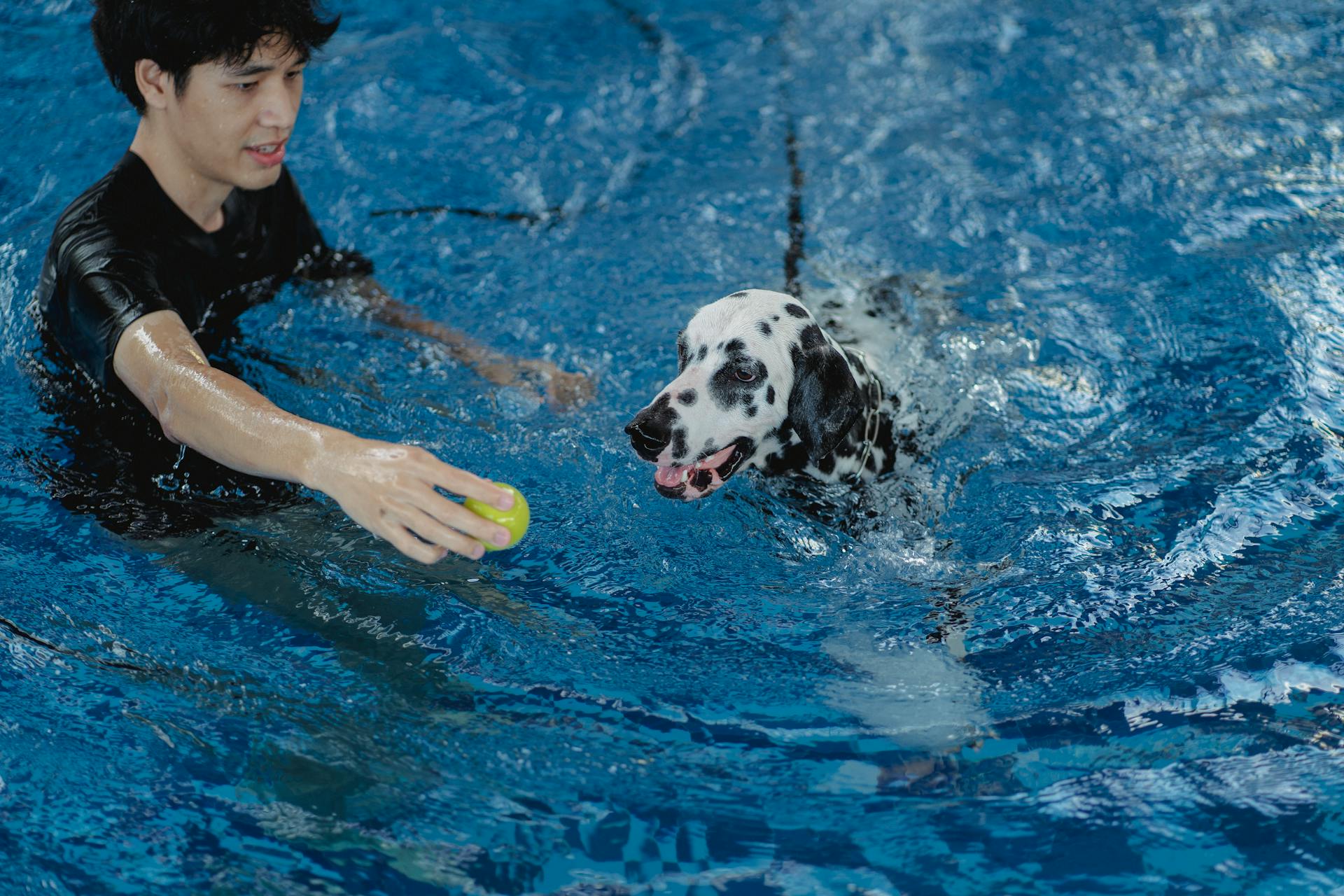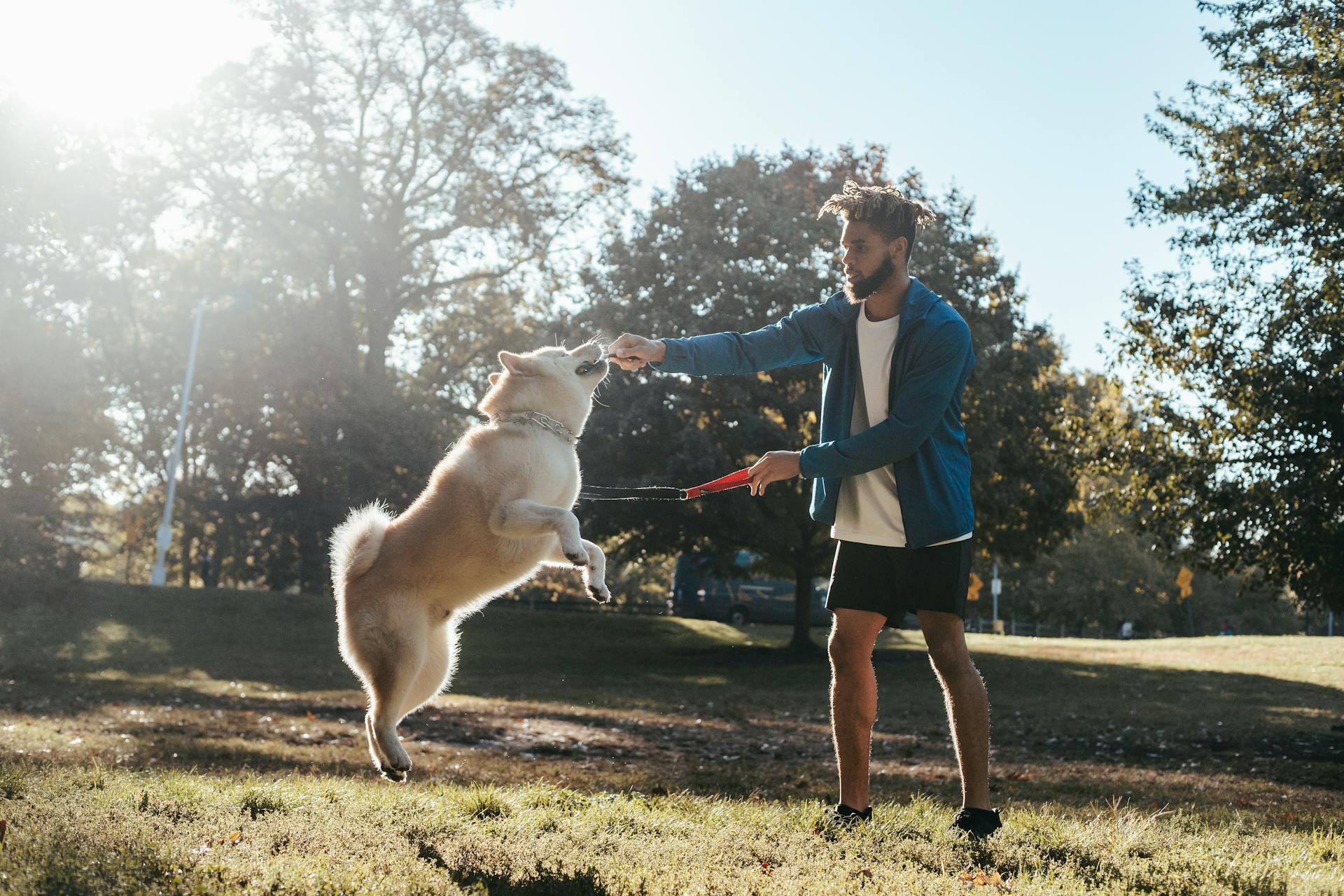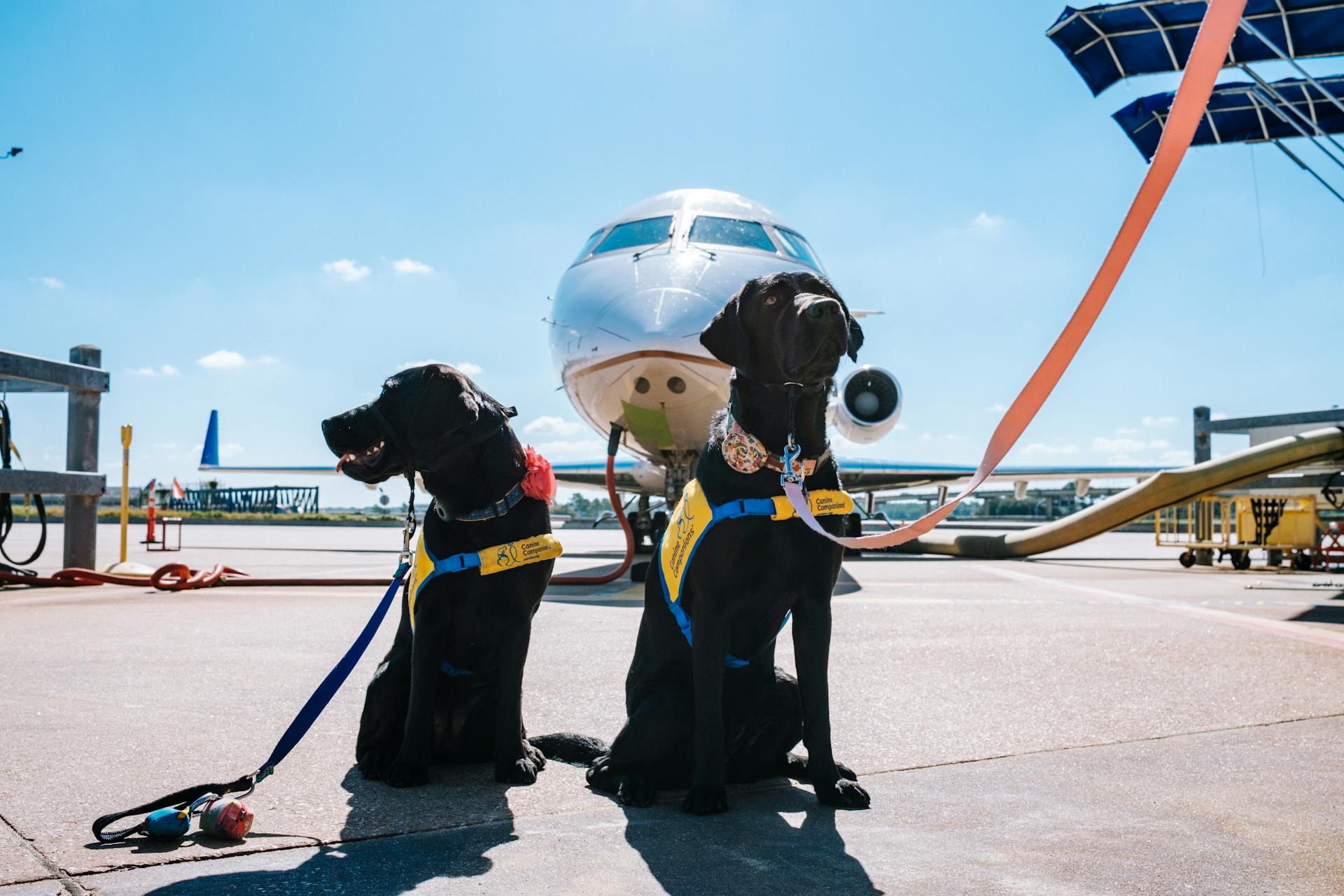
Training a deaf dog requires a different approach than training a hearing dog. This is because deaf dogs rely on visual cues rather than auditory ones.
Deaf dogs can learn to respond to hand signals, which can be just as effective as verbal commands. In fact, some deaf dogs are able to learn up to 100 hand signals.
To start training your deaf dog, it's essential to establish a strong bond with them based on trust and clear communication. This foundation will help your dog understand and respond to your hand signals.
With patience and consistency, you can teach your deaf dog to perform a variety of tasks and behaviors, from basic obedience commands to complex tricks.
Expand your knowledge: Akc Dog Training Hand Signals
Understanding Deaf Dog Training
Deaf dog training is all about adapting to their unique needs. Deafness in dogs affects their learning and interaction with the environment.
To communicate with a deaf dog, you'll need to use visual cues, such as hand signals, instead of relying on auditory cues. Cues for hearing dogs are usually words and/or hand signals, but for deaf dogs, cues may be visual, tactile, or olfactory.
Broaden your view: Dog Training Hand Signs
Hand signals and visual cues form the backbone of communicating with a deaf dog. Consistency in these gestures is key to the dog's understanding and response.
Disciplining a deaf dog effectively involves the use of clear visual signals to indicate undesirable behaviors, along with immediate and consistent feedback. A firm hand signal for "no" can be an effective way to communicate this.
Eye contact, facial expressions, and hand signals can all be used to communicate with a deaf dog. Blinking lights can even be used to signal a pet to come inside.
Some deaf dogs may perceive vibrations or high-frequency sounds, which can be useful when selecting training aids like vibrating collars.
On a similar theme: Basic Dog Printable Dog Training Hand Signals Chart Pdf
Teaching Basics
Teaching Basics is a crucial part of deaf dog training. You can start by choosing a reward that your dog loves, such as treats, and using a visual marker signal like a "thumbs up" to mark the behavior as "nicely done".
To create a positive association between the marker signal and the reward, pair the signal with the delivery of a treat. For example, show your dog the "thumbs up" and immediately toss her a treat. Repeat this process a few times in a row, and soon she will see the thumbs up and look for the reward.
Consistency is key when using visual cues. Decide on a hand signal for each behavior and stick to it. You can use hand signals from human sign language, but it's also okay to create your own. Just make sure to use one-handed signals so your other hand is free to give rewards.
Here are some essential hand signals for deaf dog training:
Remember to always reward your dog for correct behavior and use a marker signal to let them know they're doing it right.
Teaching Basics
Teaching a deaf dog requires a different approach than training a hearing dog. The first step is to choose a reward that your dog loves. This can be a treat, toy, or even affection. Be sure to use a reward that your dog finds motivating.
Recommended read: Reward Based Dog Training

To choose the right reward, consider your dog's daily food intake. You'll want to make sure your dog still eats their required daily amount of nutritious food and doesn't become overweight. Most dogs are very food motivated and will work for tiny morsels of dry dog food.
Here are some guidelines for choosing the right reward:
- Use small, soft treats that can be swallowed easily and quickly.
- Choose treats that are the size of a pea or a pencil eraser, or even smaller for tiny dogs.
- Calculate the number of calories your dog can have in a day and stay within that guideline.
Once you've found a reward your dog likes, start training! Each time your dog performs a desired behavior, deliver a treat or reward right away.
Baer Test
The BAER test is a simple and non-invasive way to determine if your dog can hear. It measures the electrical activity in the brain as it receives an auditory stimulus.
This test is usually performed on young puppies in breeds that are prone to congenital deafness or on breeding animals before they're involved in a breeding program.
Puppies and kittens must be at least six weeks old to be tested.
Worth a look: House Training an Ex Breeding Dog
Choosing the Right Gear
A standard leash is necessary for maintaining control and ensuring the dog's safety during training sessions. A vibrating collar can be a valuable tool for getting your dog's attention without any auditory cues.
The gear you choose should be comfortable for your dog and suitable for their size and strength. This will prevent any discomfort or distraction during training.
Choosing the Right Gear
A standard leash is necessary for maintaining control and ensuring the dog's safety during training sessions. This is especially important for deaf dogs who rely on visual cues.
Choose a leash that's comfortable for your dog and suitable for their size and strength. A leash that's too loose or too tight can cause discomfort and make training more difficult.
A vibrating collar can be a valuable tool for getting your dog's attention without any auditory cues. This is especially useful for deaf dogs who need to rely on vibrations to respond to commands.
Make sure the gear you choose is comfortable for your dog and is suitable for their size and strength. This will help prevent discomfort and make training more effective.
A unique perspective: Hearing Dogs for Deaf People
Collars
A standard leash is necessary for maintaining control and ensuring the dog's safety during training sessions. It's also a good idea to have a backup leash in case the primary one gets damaged.
A vibrating collar can be a valuable tool for getting your dog's attention without any auditory cues. This type of collar is not a shock collar and doesn't deliver a shock or hurt your dog in any way.
The Bark Beyond E3 E-Collar and 800m range remote is a good example of a vibrating collar that can be used to train a deaf dog. This collar delivers a gentle stimulus to help your dog focus.
Here are some key features to look for in a vibrating collar:
- Comfortable for your dog and suitable for their size and strength
- Has a low-level stimulation option, such as a 6 on a 100-level scale
- Has a vibration mode that is not too startling for your dog
- Can be used with a long lead or remote control
Remember to always reward and praise your dog for creating positive associations when using a vibrating collar. This will help your dog understand what the collar means and how to get it to turn off with their compliance.
Training Techniques
Training a deaf dog requires creative and effective techniques. One of the most important strategies is to use visual and tactile signals to replace auditory cues.
To train a deaf dog, you must employ visual signals such as a flashlight or a vibrating collar to grab their attention from a distance. Training should be done in a safe, enclosed area to prevent the dog from running into danger.
Positive reinforcement training is the most accepted form of training today, which is based on rewarding desired behaviors. Rewards can range from high-value treats, praise, and toys to plenty of verbal encouragement.
To teach a deaf dog to heel during walks, use a leash and treats to guide them to walk beside you by rewarding them when they stay in the correct position. Reinforce the behavior through hand signals and consistent practice.
Shaping behavior is very important for teaching a dog to think on their own. With shaping training, the final behavior is broken down into smaller steps that are taught progressively. Each step gets closer to the final behavior, making it easier for a dog to learn.
Expand your knowledge: Free Shaping in Dog Training
Hand signals and visual cues form the backbone of communicating with a deaf dog. Basic obedience commands such as sit, stay, come, lie down, and off-leash behavior can all be taught using hand gestures that the dog can easily distinguish and remember.
Consistency in hand signals is key to the dog's understanding and response. A firm hand signal for "no" or guiding them to an alternative behavior can be effective in disciplining a deaf dog.
Here are some effective training techniques for deaf dogs:
- Luring: Use a treat and a hand gesture to lure your dog into a desired position or behavior.
- Capturing: Catch your dog in the act of performing a desired behavior and reward them immediately.
- Shaping: Break down complex behaviors into smaller steps and reward each step until the final behavior is achieved.
- Touch-Based Methods: Use gentle pats or a series of touches to signal different commands and maintain focus.
- Marker Signals and Vibrations: Use a vibration collar or a flashing light to mark desired behaviors and provide positive reinforcement.
Communication and Recall
Communicating with a deaf dog requires patience and consistency. Since verbal commands are no longer effective, visual signals become the main method of communication.
To establish a clear set of instructions, use visual cues and hand signals for commands like sit, stay, and come. A vibrating collar can help gain a deaf dog's attention and facilitate training without reliance on verbal commands.
Training a deaf dog to come when called involves employing visual signals such as a flashlight or a vibrating collar to grab their attention from a distance. This should be done in a safe, enclosed area to prevent the dog from running into danger.
For more insights, see: Deaf and Blind Dog Training
Positive reinforcement is key in training a deaf dog. Reward them with treats, toys, or affection to reinforce their good behavior. Consistency in routines and commands helps deaf dogs predict and understand their environment, reducing anxiety and fostering trust.
Here are some effective recall training techniques for deaf dogs:
Some trainers recommend using tactile and visual clues when training a deaf dog, and even scent can be used for recall. However, it's essential to exercise caution and not let a deaf dog off-leash outside of fenced areas due to safety concerns.
Discover more: Deaf Dogs
Behavioral Challenges and Solutions
Deaf dogs often experience challenges such as startling easily or difficulty in focusing.
These challenges can be managed through touch signals to get the dog's attention, allowing them to focus better.
Touch signals can help deaf dogs overcome their difficulties in focusing and reduce anxiety.
Intriguing read: In Touch Dog Training
Common Behavioral Challenges and Solutions
Deaf dogs often experience challenges such as startling easily or difficulty in focusing. These can be managed through touch signals to get the dog's attention.
A marker signal, like a flash of light or a gentle vibration from a vibration collar, can immediately follow successful completion of a behavior, letting the dog know they executed the command correctly.
Positive reinforcement is key to rewarding desirable behavior, reducing anxiety, and improving focus in deaf dogs. This can be achieved by using a lure-and-reward system that guides the dog through the desired action.
A gentle vibration from a vibration collar can be a useful tool to get a deaf dog's attention and guide them through a behavior. This can be especially helpful in distracting environments.
Check this out: Training a Dog with a Vibrating Collar
2020 Study
A 2020 study on hearing loss in dogs found that noise-induced hearing loss often results from damage to the hair cells in the cochlea that vibrate in response to sound waves.
Extreme noise can also damage the eardrum and the small bones within the inner ear, called the ossicles, leading to further hearing loss.
This is crucial to understand because loud noises can be a common occurrence in many households, especially with the presence of dogs.
Readers also liked: Noise Maker Dog Training
Frequently Asked Questions
Can a deaf dog hear a dog whistle?
While some deaf dogs can hear certain frequencies, a dog whistle is not a reliable way to communicate with a deaf dog. However, if your dog can hear a dog whistle, using it can be a useful tool to identify and communicate with them.
Sources
- https://vcahospitals.com/know-your-pet/teaching-and-training-a-deaf-dog
- https://roguepetscience.com/blogs/dog-training/how-to-train-a-deaf-dog
- https://www.dogster.com/lifestyle/how-to-train-a-deaf-dog
- https://www.petmd.com/dog/training/how-train-deaf-dog
- https://barkbeyond.com/blogs/review/e-collar-training-for-deaf-dogs
Featured Images: pexels.com


